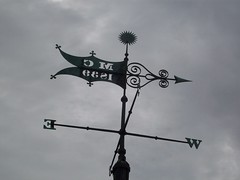 A weathervane is a simple device indicating wind direction. Weathervane is a moveable device that, when attached to a rooftop or other elevated object, clearly and easily shows the direction of the wind. The device's original name is a wind vane, for obvious reasons, and purists today will still refer to it as such. A properly designed, balanced and crafted weathervane will customarily point into the wind, although some weathervanes have been designed to do just the opposite: for example, a weathervane crafted as a dragon may be designed to point his back to the wind instead of his head, this is due to the nature of the creature and the myths that surround it.
A weathervane is a simple device indicating wind direction. Weathervane is a moveable device that, when attached to a rooftop or other elevated object, clearly and easily shows the direction of the wind. The device's original name is a wind vane, for obvious reasons, and purists today will still refer to it as such. A properly designed, balanced and crafted weathervane will customarily point into the wind, although some weathervanes have been designed to do just the opposite: for example, a weathervane crafted as a dragon may be designed to point his back to the wind instead of his head, this is due to the nature of the creature and the myths that surround it.Weathervanes are classified by two basic, but distinct rules, of design. The ornament must have unequal area on either side of the center, and must also have equal mass on either side of the center as well. The pointer must be capable of moving freely and fluidly on its axis as well. So in other words, the weathervane must be balanced so that exactly half of its weight is on both sides of the axis, but that the surface area exposed to the wind is unbalanced. This is so the wind can create enough momentum for the weathervane to turn into the direction of the wind but, since the mass of the weathervane is equal on both sides, so that it won't tilt or fall - it will simply turn.
The formation of a weathervane includes a small end and a large end. Whether in the shape of an arrow or an animal, weathervanes all share this characteristic of a large and small end. They are then usually designed for the small end to point in the direction of the wind, and due to the balance of mass and unequal momentum of the weathervane, the smallest end will point into the source of the wind. Since winds are named by the direction in which they blow, such as a northern or southeastern wind, weathervanes will customarily include a directional arrow as well, indicating geographical direction. So when a weathervane's smallest end points in the direction of the wind, you will know exactly what direction that wind is coming from: north, south, east or west.
In earlier times, weathervanes served very decorative purposes. They were ornamental pieces found atop important buildings and churches, and sported fanciful shapes and figures. Although they can serve a similar purpose today, modern weathervanes also serve very functional purposes. Sat atop remote reading stations and weather stations, weathervanes are very instrumental in measuring wind speed and direction. Coupled with technological instrumentation, weathervanes can be read from both inside and outside a building, home or office. This makes weathervanes a very versatile device, no matter whether it was designed for decorative purposes or functionality.
Author: Jesse Akre
Tidak ada komentar:
Posting Komentar